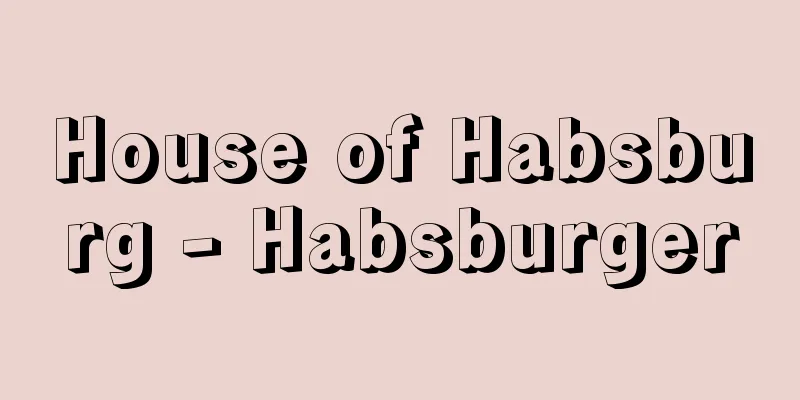House of Habsburg - Habsburger

|
The former Austrian imperial family has been one of the most prestigious families in Europe since the Middle Ages. The family is of noble descent from northern Switzerland, and its name comes from the mountain castle Habsburg (meaning hawk's castle). [Makio Shindo] Towards the realization of a world empireIn 1273, when Rudolf I (reigned 1273-91) was elected King of Germany, he confiscated the Duchy of Austria as part of his family estates. Although they were defeated in the Swiss War of Independence in the 14th century, they further expanded their domains in the East, and Rudolf IV (Prince of the Founders, 1339-65) forged a Great Charter and called himself Archduke. In 1452, Frederick III (reigned 1452-93) became Holy Roman Emperor, and thereafter the House of Habsburg virtually monopolized the imperial throne. Later, through a skillful marriage policy, Maximilian I (reigned 1493-1519) annexed Spain and Burgundy, and under his grandson Charles V (reigned 1519-56; as King of Spain he was Charles I, reigned 1516-56), the global Habsburg Empire was realized. In 1522, according to the Concordat of Brussels on succession, Charles V handed over his German lands and right to the imperial throne to his younger brother Ferdinand I (reigned 1556-64), and in 1526 he added Bohemia and Hungary to his succession. However, with the Protestant Reformation and subsequent conflicts in Germany, he abdicated the following year after the Peace of Augsburg in 1555, against his will. [Makio Shindo] Transition of Spanish and Austrian descentCharles V's eldest son, Philip II (reigned 1556-98), promoted the Counter-Reformation and the Kingdom of Spain reached its peak, but it also came into conflict with France, England and the Netherlands, leading to its decline. Germany also experienced religious strife and disputes over succession, and under Ferdinand II (reigned 1619-37) the Thirty Years' War broke out, leaving the country in ruins, but Leopold I (reigned 1658-1705) secured all of Hungary as his family estate, and Vienna became the centre of the Danube Empire, where Baroque culture flourished. Meanwhile, the Spanish line came to an end with Charles II (reigned 1665-1700), and as a result of the War of Spanish Succession, the throne was passed to the House of Bourbon by the Treaty of Utrecht in 1713. [Makio Shindo] Age of EnlightenmentThe Austrian Charles VI (reigned 1711-40) established the Pragmatiste Sanction (State Decree) in 1713 and made efforts to ensure that all family lands were undivided and inherited together, but his eldest daughter Maria Theresa (reigned 1740-80) lost Silesia to the War of Austrian Succession and the Seven Years' War. Emperor Charles VII was elected from Bavaria for a time, but after his death he regained the throne with the Treaty of Dresden in 1745. Under the joint rule of her husband Franz I (reigned 1745-65) and her eldest son Joseph II (reigned 1765-90), she promoted enlightened domestic reforms, built a civic-minded family even at court, and was revered as the Mother of the Nation. Joseph II implemented radical reforms such as the Edict of Toleration and the Emancipation of the Serfs, but after the outbreak of the French Revolution, the enlightened monarch Leopold II (reigned 1790-92) was unable to prevent reactionary movements within the country amid international reactionary sentiment. [Makio Shindo] Austrian EmpireThe Holy Roman Empire was dissolved in 1806 due to the Napoleonic Wars, and the last emperor, Franz II (reigned 1792-1806), became Emperor of Austria Franz I (reigned 1804-35) in 1804, and stood at the apex of the Metternich regime. Facing the March Revolution of 1848, Franz Joseph I (reigned 1848-1916) came to power in December of the same year and led the counter-revolution to victory, but with the rise of the bourgeoisie and the rise of nationalism among various ethnic groups, the empire wavered between reactionary centralization and the Enlightened federalization of various ethnic groups. He was defeated in the Italian War in 1859 and the Prussian-Austrian War in 1866, and established the Austro-Hungarian Empire in 1867 with the Ausgleich (compromise). However, as discontent among the Slavic peoples grew, he concluded the German-Austrian Alliance in 1879 and became mired in the Balkan problem. The aged emperor also suffered a series of family tragedies, with his nephew and heir to the throne, Franz Ferdinand, and his wife being assassinated in 1914 (the Sarajevo Incident), and he ended his life worrying about the future of the royal family during World War I. Despite the maneuverings of the last Austrian Emperor, Charles I (reigned 1916-18), the collapse of the empire following defeat in the war also brought an end to the history of the Habsburg dynasty. [Makio Shindo] ©Shogakukan "> House of Habsburg / Brief family tree Source: Shogakukan Encyclopedia Nipponica About Encyclopedia Nipponica Information | Legend |
|
オーストリアの旧帝室で、中世以来ヨーロッパ随一の名家。スイス北部出自の貴族の家系で、家名は山城ハプスブルクHabsburg(鷹(たか)の城の意)に由来する。 [進藤牧郎] 世界帝国の実現まで1273年ルドルフ1世(在位1273~91)がドイツ国王に選ばれると、家領としてオーストリア公領を没収した。14世紀スイスの独立戦争に敗れたが、東方では家領をさらに広げ、ルドルフ4世(建設公、1339―65)は大特許状を偽造して大公と称した。1452年、フリードリヒ3世(在位1452~93)が神聖ローマ皇帝となり、以後ハプスブルク家は皇帝位を事実上独占するに至った。その後巧みな婚姻政策により、マクシミリアン1世(在位1493~1519)は、スペイン、ブルグントを併合し、孫カール5世(在位1519~56。スペイン王としてはカルロス1世、在位1516~56)の下で、ハプスブルク世界帝国が実現する。1522年、カール5世は相続に関するブリュッセル協約により、弟フェルディナント1世(在位1556~64)にドイツの家領と皇帝位継承権を譲り、1526年ボヘミア、ハンガリーを加えたが、ドイツでは宗教改革とその後の争乱のなかで、意に反しての1555年のアウクスブルクの和議ののち、翌年自ら退位した。 [進藤牧郎] スペイン・オーストリア両系の推移カール5世の長子フェリペ2世(在位1556~98)は、反宗教改革を推進、全スペイン王国は最盛期を迎えたが、フランス、イギリスに加えてオランダとも敵対し、衰退に向かう。ドイツでも宗教争乱と相続争いが続き、フェルディナント2世(在位1619~37)の下で三十年戦争となり、国土は荒廃したが、家領ではレオポルト1世(在位1658~1705)が全ハンガリーを確保して、ウィーンはドナウ帝国の中心となり、バロック文化を開花させた。一方、スペイン系はカルロス2世(在位1665~1700)で断絶し、スペイン継承戦争の結果1713年のユトレヒト条約によって王位はブルボン家に移った。 [進藤牧郎] 啓蒙主義時代オーストリア系のカール6世(在位1711~40)は、1713年プラグマティッシェ・ザンクツィオン(国事詔書)を定め、全家領の不分割と一括相続実現のため努力したが、長女マリア・テレジア(在位1740~80)はオーストリア継承戦争、七年戦争に直面してシュレージエンを失う。一時バイエルンから皇帝カール7世が選出されていたが、その死を機に1745年ドレスデンの和約で帝位を回復し、夫フランツ1世(在位1745~65)、長子ヨーゼフ2世(在位1765~90)との共同統治の下で啓蒙(けいもう)的な国内改革を進め、宮廷でも市民的な家庭を築き、国母として敬慕された。ヨーゼフ2世は寛容令、農奴解放令などの急進的改革を行ったが、フランス革命の勃発(ぼっぱつ)後、国際的反動化のなかで啓蒙君主レオポルト2世(在位1790~92)は国内の反動化の動きを防ぎきれなかった。 [進藤牧郎] オーストリア帝国ナポレオン戦争により、1806年神聖ローマ帝国は解体し、最後の皇帝フランツ2世(在位1792~1806)は1804年オーストリア皇帝フランツ1世(在位1804~35)を称し、メッテルニヒ体制の頂点にたった。1848年の三月革命に直面し、同年12月フランツ・ヨーゼフ1世(在位1848~1916)がたち、反革命を勝利に導いたが、ブルジョアジーの台頭と諸民族のナショナリズムの高揚により、反動的な中央集権化と啓蒙主義的な諸民族の連邦化の間を動揺する。彼は、1859年イタリア戦争、66年プロイセン・オーストリア戦争に敗れ、67年アウスグライヒAusgleich(妥協)でオーストリア・ハンガリー帝国を成立させたが、スラブ系諸民族の不満が高まり、1879年ドイツ・オーストリア同盟を締結してバルカン問題の泥沼にはまり込む。老帝には家庭的悲劇も続き、1914年甥(おい)で皇嗣(こうし)のフランツ・フェルディナント夫妻が暗殺され(サライエボ事件)、第一次世界大戦のなかで王家の前途を憂えながら生涯を閉じた。最後のオーストリア皇帝カール1世(在位1916~18)の工作にもかかわらず、敗戦による帝国の崩壊でハプスブルク王家の歴史も幕を閉じた。 [進藤牧郎] ©Shogakukan"> ハプスブルク家/略系図 出典 小学館 日本大百科全書(ニッポニカ)日本大百科全書(ニッポニカ)について 情報 | 凡例 |
>>: Pabst - Georg Wilhelm Pabst
Recommend
Kogen - Kogen
Chinese woodcarver from Guangdong. He studied at t...
El Dorado (English spelling)
A legendary golden country that the 16th century S...
Daphne cneorum (English name) Daphnecneorum
… [Toshio Hamatani]. … *Some of the terminology t...
Fair Trade Commission
A specialized agency responsible for enforcing th...
Cape (English spelling)
A former province that occupied the southwestern h...
Rogers, R.
...The street performers in the square in front o...
Sea lily (umi-yuri) - sea-lily (English spelling)
A general term for echinoderms belonging to the or...
Kaeri - Return
…They are also called Nanatsuboshi because of the...
Anser erythropus; lesser white-fronted goose
Anseriformes, Anatidae. Total length 53-66cm. Simi...
Upstream (nuclear fuel)
…Focusing on this property, the radioactivity of ...
Green foxtail - Enokorogusa
An annual weed of the grass family (APG classific...
Carole
...Examples include the everyday, common people&#...
Mount Entsu
...A temple of the Rinzai sect of Buddhism, Daito...
Twelve Years' War in Oshu - Oshu Jyuunienkassen
...A war fought between Minamoto no Yoriyoshi, th...
Kan'ei coins
⇒ Kanei Tsūhō Comments Source: About Shogakukan Di...









